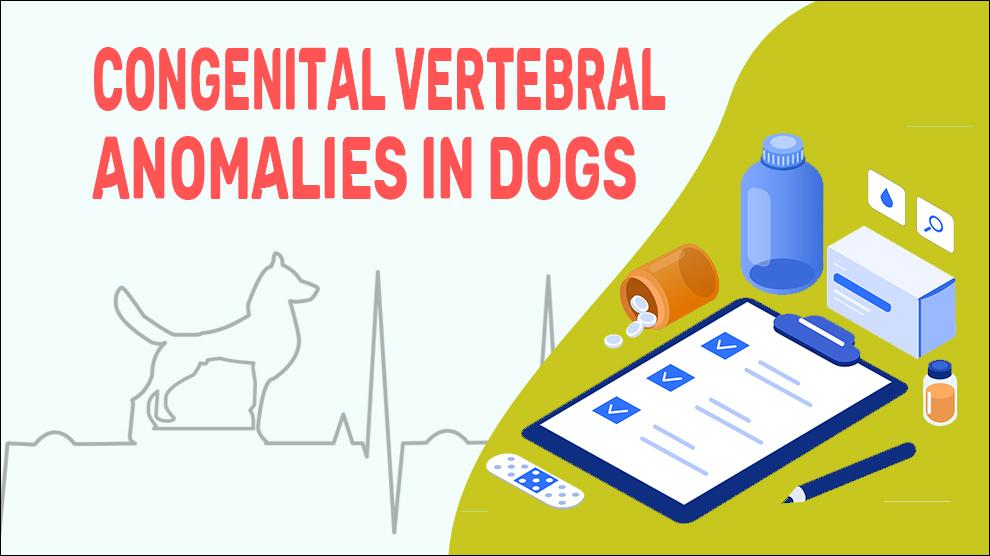Congenital vertebral malformations (CVM) are congenital, non-inflammatory, progressive, degenerative conditions of the vertebral column.
The overall incidence has not been established exactly and it is irreversible. It is a very common incidental finding (95%) in brachycephalic dogs like Pugs, English Bulldogs and French Bulldogs.
These changes can range from intricate combinations of multiple CVMs or just one transitional vertebra.
Congenital vertebral malformations are very rare in dogs and most of the cases are due to genetic inheritance. However, there are no established gene defects that exclusively relate to this disorder.
Similarly, many congenital vertebral malformations are attributed to intrauterine exposures such as antiepileptic drugs, hyperglycemia, or carbon monoxide.
Spinal deformity is a significant concern associated with congenital vertebral anomalies, namely kyphosis, scoliosis, or a combination of the two. However, most the congenital abnormalities of the spine remain asymptomatic throughout life.
Symptoms Of Congenital Vertebral Anomalies
- Deviation of the spine.
- Pain, stiffness, and lameness.
- Restlessness, or seemingly uncomfortable.
- Limping / Abnormal gait
- Caudal to the lesion.
- Reluctance to move or refusing to use stairs or jump.
- Lack of enthusiasm for walks.
- A noticeable change in behaviors, such as increased irritability or whining, or aggression.
Treatment Options For Congenital Vertebral Anomalies
It is important to understand that for the treatment of CVM in dogs the focus is management rather than cure. Success in treatment means minimizing pain while maximizing your dog's comfort and function.
- Bone Growth Optimization: Limiting food consumption and avoiding calcium supplementation.
- Maintaining Healthy Weight: Noticeably decreases the rate of CVM progression in dogs
- Pain Management:
- Nonsteroidal anti-inflammatory drugs (NSAIDs).
- Nutritional supplementation - omega-3 fatty acids and undenatured collagen.
- Electrophysical modalities, such as cold therapy.
- Anti-inflammatories
- Amantadine - brand names - Gocovri, Osmolex ER, Symmetrel and Endantadine.
- Therapeutic Exercise: Dogs exercising or playing more is associated with a lower lameness score (on par with the benefits of NSAIDs).
- Hemivertebrae: Surgical decompression and stabilization.
Home Remedies For Congenital Vertebral Anomalies
Hydrotherapy - (or aquatic therapy) is a type of physical therapy utilizing the buoyancy of water where dogs perform certain exercises in water and it helps to maintain muscle mass.
Physical Therapy - May include massage, ultrasound therapy, electric stimulation, and application of heat and cold to help relieve pain in the spine.
Prevention Of Congenital Vertebral Anomalies
CVM etiology is poorly understood. Prevention is not possible for CVM as the causes in dogs are varied. Treatment and survival rates vary depending on the grade and stage of the CVM.
Specific causes are not yet known. However, hereditary is a factor in some breeds and it is better to evaluate the affected dogs before breeding or at least before getting a dog from a susceptible lineage and get the health checks done.
Affected Breeds Of Congenital Vertebral Anomalies
French Bulldog, English Bulldog, Boston Terrier, Pug, Dachshund, Lhasa Apso
Additional Facts For Congenital Vertebral Anomalies
- Risk Factors:
- Genetics (for congenital vertebral anomalies).
For Acquired Anomalies:
- Lifestyle factors: Obesity, Posture, Overuse of joints, etc.
- Older age
- Spinal injuries
- Certain metabolic diseases: Hemochromatosis, Diabetes, etc.
- Types:
(i) Block Vertebrae: No clinical signs. Partial or complete fusion of two neighboring vertebrae lacking an intervertebral disc space between them.
(ii) Butterfly Vertebrae: Usually insignificant condition. X-ray shows butterfly-shaped vertebrae resulting from a cleft in the vertebrae. Boston Terriers, English Bulldogs, French Bulldogs, etc.
(iii) Hemivertebrae: Vertebrae are wedge-shaped and the thoracolumbar spine is usually involved. The difference in spine curvatures is caused due to defects on top, below, or only one side of the vertebra. Wobbly gait and Progressive paralysis are also observed.
(iv) Spina Bifida: Spinal column is not formed properly due to the presence of a cleft in the middle of the vertebral arch or absence of vertebral arches. Depending on the affected site of the spinal cord, clinical signs are observed. The condition usually affects the lower back spine and it is also more commonly seen in 'screw-tailed' breeds.
- Mortality:
There is no evidence of CVM alone affecting the life span. There are few studies that state dogs with CVM have a higher mortality rate than dogs without CVM ( both are of the same age).
- Diagnosis:
- X-rays
- MRI and CT scan
- Arthroscopy
- Prognosis:
Vertebral anomalies are congenital disease that requires continuous treatments. The prognosis for this condition is guarded. As the existing condition is not life-threatening, rigorous treatment is usually not necessary. Proper treatment and home care are the best defenses against future complications.
When To See A Vet
Contact your vet right away, if you notice any of the following:
- Pain, stiffness, and lameness.
- Limping / Abnormal gait
- Deviation of the spine.
Food Suggestions For Congenital Vertebral Anomalies
Foods to avoid:
- Grains: Rice, Wheat, Soy, etc.
- Corn
- Commercial diet (kibble and/or canned food).
- Avoid fatty proteins (go for lean proteins).
- Treats, Table scraps, Added Salts, Sugars, and Artificial Additives.
Foods to feed:
- Leafy greens: Spinach, lettuce, kale, green beans.
- Fiber-filled veggies: Pumpkin, Sweet potato, acorn squash.
- Fatty fish: Salmon, tuna, sardines, mackerel, etc.
- Lean protein: Chicken, Turkey.
- Omega-3 oils: Fish oil, green-lipped mussel oil.
- Antioxidant-packed fruits: Cherries, Blueberries, Peeled apple, Cantaloupe.
- Vitamin-rich veggies:Cauliflower, Broccoli, etc.
- Herbs and spices - Fresh ginger root, Turmeric, Cinnamon, Parsley, etc.
Conclusion
Congenital vertebral anomalies need life-long management as it is a long-term conditions. CVM is a progressive condition and there is no known cure, but if well managed, most pets can live comfortable lives for many years.

















